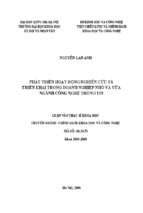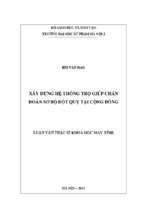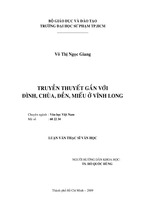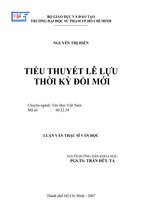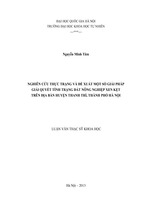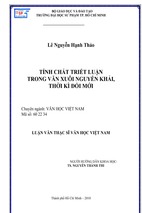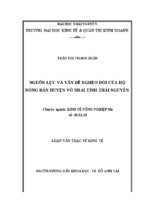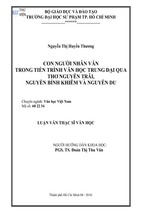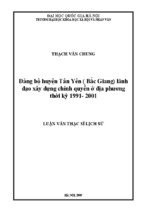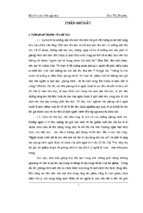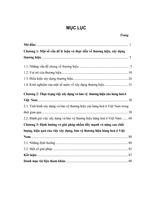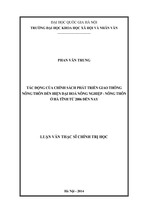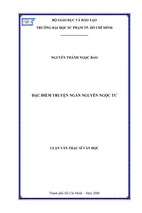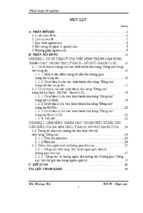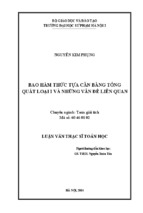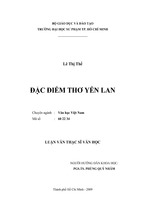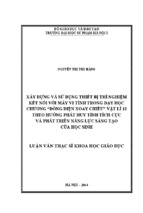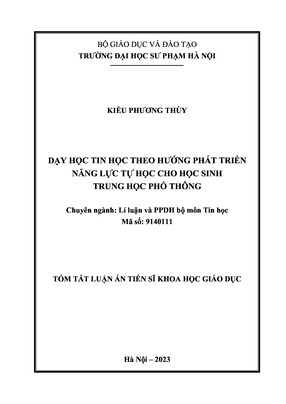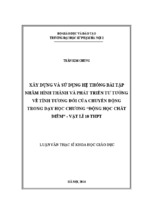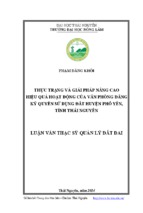Enhancing students’ motivation has always been an immense intact field in Vietnam’s educational system, which is awaiting scholars and researchers to cultivate in and bring fruitful changes to the wellbeing of their own students. With her deep concern about this notion, I carried out a study titled “ The implementation of motivational teaching strategies in Vietnam’s high schools”. The aims of this study was to describe how high school teachers and students in Vietnam perceive the use of motivational teaching strategies in EFL classrooms, identify the motivational strategies utilized by teachers and reveal the effects of those strategies on students’ behaviors in the class. This study follows both quantitative and qualitative research methods. Questionnaire, interviews and observation were employed to triangulate the information from various aspects and hence ensure the validity as well as reliability of the research.
gf
VIETNAM NATIONAL UNIVERSITY, HANOI
UNIVERSITY OF LANGUAGES AND INTERNATIONAL STUDIES
FACULTY OF ENGLISH LANGUAGE TEACHER EDUCATION
GRADUATION PAPER
THE IMPLEMENTATION OF MOTIVATIONAL
TEACHING STRATEGIES IN VIETNAM’S
HIGH SCHOOLS
Supervisor
: Phạm Ngọc Khánh Ly, M.A
Student
: Lưu Cẩm Hà
Course
: QH2015.F1.E3
HÀ NỘI - 2019
ĐẠI HỌC QUỐC GIA HÀ NỘI
TRƯỜNG ĐẠI HỌC NGOẠI NGỮ
KHOA SƯ PHẠM TIẾNG ANH
KHÓA LUẬN TỐT NGHIỆP
NGHIÊN CỨU VỀ VIỆC THỰC HIỆN CÁC
CHIẾN LƯỢC DẠY TẠO ĐỘNG LỰC Ở
CÁC TRƯỜNG THPT TẠI VIỆT NAM
Giáo viên hướng dẫn : Ths. Phạm Ngọc Khánh Ly
Sinh viên
: Lưu Cẩm Hà
Khóa
: QH2015.F1.E3
HÀ NỘI – 2019
ACCEPTANCE
I hereby state that I: Luu Cam Ha, QH.2015.F1.E3, being a candidate for the
degree of Bachelor of Arts (programme) accept the requirements of the College
relating to the retention and use of Bachelor’s Graduation Paper deposited in the
library.
In terms of these conditions, I agree that the origin of my paper deposited in
the library should be accessible for the purposes of study and research, in
accordance with the normal conditions established by the librarian for the care,
loan or reproduction of the paper.
Student
Lưu Cẩm Hà
ACKNOWLEDGEMENTS
First of all, I would like to express my gratitude to my devoted supervisor, Ms.
Pham Ngoc Khanh Ly, M.A whose intellectual consultancy and spiritual
encouragement were an indispensable factor in the fulfillment of this research.
Besides, I sincerely appreciate the cooperation of teachers and students from
Thanh Hoa‘ high schools in finishing the questionnaires, participating in the
interviews and allowing me to observe their classrooms.
Last but not least, I want to thank all of my beloveds, without whom I could
not have completed this project. Thank my peer, Nguyen Thi Phuong Linh, for her
instant support and knowledgeable suggestions. Thank my sister, Ngo Lan Huong ,
for her unconditional love and care during the stressful time of research. Most
remarkably, I am grateful to my family members for loving, understanding,
supporting and encouraging me to overcome difficulties to complete this work.
i
ABSTRACT
Enhancing students‘ motivation has always been an immense intact field in
Vietnam‘s educational system, which is awaiting scholars and researchers to
cultivate in and bring fruitful changes to the wellbeing of their own students. With
her deep concern about this notion, I carried out a study titled ― The implementation
of motivational teaching strategies in Vietnam‘s high schools‖. The aims of this
study was to describe how high school teachers and students in Vietnam perceive
the use of motivational teaching strategies in EFL classrooms, identify the
motivational strategies utilized by teachers and reveal the effects of those strategies
on students‘ behaviors in the class. This study follows both quantitative and
qualitative research methods. Questionnaire, interviews and observation were
employed to triangulate the information from various aspects and hence ensure the
validity as well as reliability of the research.
The study yielded significant findings in response to the proposed questions.
Firstly, the study confirms that high school teachers in Vietnam were aware of the
importance of motivational practices in EFL classroom. However, there were some
strategies that were highlighted by teachers but not recognized by students. Next,
the observation revealed that the most popular and effective motivational strategies
demonstrated in classrooms are: establishing relevance, class applause, tangible
reward, process feedback, intellectual challenge, pair work, scaffolding, individual
competition, and team competition. These strategies have triggered a high level of
student‘s attention, participation and volunteering.
Based on these findings, implications were made for teachers and classroom
teaching. With a view to enhancing learners‘ motivation in particular and improving
the quality of teaching and learning English in general, not only do teachers have to
apply effective motivational strategies perceived by students more frequently but
they also need to reconsider the implementation of motivational strategies that were
not appreciated by students.
ii
TABLE OF CONTENTS
ACKNOWLEDGEMENTS............................................................................. i
ABSTRACT ..................................................................................................... ii
TABLE OF CONTENTS ............................................................................... iii
LIST OF FIGURES AND TABLES ............................................................. vi
CHAPTER 1: INTRODUCTION .................................................................. 1
1.1 Rationale for the study and the statement of problems of the research ...... 1
1.2. Aims and objectives of the study ........................................................ 2
1.3. Scope of the study ............................................................................... 2
1.4 Methods of the study ........................................................................... 3
1.4.1 Data collection methods ............................................................ 3
1.4.2. Data analysis methods ............................................................. 3
1.5. An overview of the rest of the paper .................................................. 3
CHAPTER 2: LITERATURE REVIEW ...................................................... 5
2.1. Motivation........................................................................................... 5
2.1.1. Definitions ................................................................................ 5
2.1.2. The role of motivation in second/foreign language learning ... 6
2.1.3. The relationship between teaching strategies, learners’
motivation and learners’ academic performance .............................. 7
2.2. Motivational strategies ....................................................................... 9
2.2.1. Definitions ................................................................................ 9
2.2.2. Motivational teaching strategies in the field of learning and
teaching .............................................................................................. 9
CHAPTER 3: METHODOLOGY............................................................... 15
3.1. Research design ................................................................................ 15
3.2. The research setting .......................................................................... 15
3.3. Research Participants ........................................................................ 16
3.3.1. Teachers.................................................................................. 16
iii
3.3.2. Students................................................................................... 16
3.4. Data collection instrument ................................................................ 16
3.4.1. Student Questionnaire ............................................................ 17
3.4.2. Semi-structured interview ...................................................... 17
3.4.3. Classroom Observation .......................................................... 18
3.5. Data collection procedure ................................................................. 22
3.6. Data analysis ..................................................................................... 23
CHAPTER 4: FINDINGS AND DISCUSSION ......................................... 25
4.1. Research question 1: How do high school teachers and students in
Vietnam perceive the use of motivational teaching strategies in EFL
classrooms? .............................................................................................. 25
4.1.1. Perceptions of teachers .......................................................... 25
4.1.2. Perceptions of students ........................................................... 27
4.1.3. The relationship between teachers’ and students’ perception of
motivational strategies ..................................................................... 29
4.2. Research question 2: How do teachers apply motivational strategies
in their teaching practices? ...................................................................... 30
4.3. Research question 3: How do the teachers‘ motivational teaching
strategies affect students‘ classroom motivation in terms of the level of
their attention, participation and volunteering? ....................................... 31
4.3.1. The impact of motivational teaching practice on students’ level
of attention in classroom. ................................................................. 32
4.3.2. The impact of motivational teaching practice on students’ level
of participation in classroom. .......................................................... 33
4.3.3. The impact of motivational teaching practice on students’ level
of volunteering in classroom. .......................................................... 34
CHAPTER 5: CONCLUSION ..................................................................... 36
5.1. Summary of findings ........................................................................ 36
5.2. Implications ...................................................................................... 36
iv
5.3. Limitations of the research ............................................................... 37
5.4. Suggestions for further studies ......................................................... 38
REFERENCE ................................................................................................ 40
APPENDICES ............................................................................................... 45
v
LIST OF FIGURES AND TABLES
FIGURES
Figure 1: The Components of a Motivational L2 Teaching Practice (Dornyei,
2001b, p.29) .................................................................................. 10
Figure 2: Dornyei’s semi-intuitive set of ten motivational teaching strategies
(1996) ............................................................................................ 11
Figure 3: Ten commandments of motivation based on Dornyei & Csizer’ study
(1998, p.215) ................................................................................. 12
Figure 4: Motivational strategies’ impact on students’ level of attention ...... 32
Figure 5: Motivational strategies’ impact on students’ level of participation 33
TABLES
Table 1: The 25 Observational Variables Measuring the Teacher’s
Motivational Practice (Guiiloteaux & Dornyei, 2008, p.63) ....... 19
Table 2: Observational Variables Measuring Learners’ Motivated Behavior
(Guiiloteaux & Dornyei, 2008, p.62) ............................................ 22
Table 3: Means of motivational strategies perceived by students .................. 28
Table 4: Common strategies perceived by teachers and students .................. 29
vi
CHAPTER 1: INTRODUCTION
This chapter presents the rationale of the study as well as the aim, the
objectives, and the scope of the research.
1.1 Rationale for the study and the statement of problems of the research
There are various researchers in the field of language learning that showed
motivation is a very important factor of learning (Dornyei, 2001a; Brok Den, Levy,
Brekelmans & Wubbels, 2006; Oxford & Shearin, 1994; Oxford, 1994). Likewise,
Dornyei (2001a) also puts an emphasis on motivation of students when learning a
new language. In learning a foreign/ second language, motivation is indeed one of
the most important and influential factor to individuals in language learning
(compared with aptitude, learning style and the age of the learners) (Dornyei,
2001a). Regardless of aptitude, learners‘ ability and intelligence, students with
higher motivation are likely to learn more effectively.
During the 1990s, the research about motivation for learning English as a
second language (ESL) evolved into describing and focusing into the factors that
impact the motivation of the students (Cheng & Dornyei, 2007). Notwithstanding
such concern, the number of studies on how to enhance motivation of students using
specific strategies or through the application of the theory of centralized knowledge
in practical classes is relatively small in specific situations (Dornyei & Otto, 1998).
On the other hand, the ESL teachers should also be aware of contexts of the
research about motivation because specific strategies of a particular study may not
be appropriate for all ESL teaching and learning actitivities or situations.
In the Vietnamese EFL context, English teaching and learning have confronted
several obstacles. Two main factors are identified by Hoang (2018) as students‘ low
motivation and limited opportunities to practice communicating in the target
language. Alerted by the need to renovate foreign language education, the Ministry
of Education and Training (MOET) has invested abundant resources, both
intellectual and material, in the National Foreign Language Project 2008-2020,
aiming to enhance EFL teachers‘ proficiency through extensive training programs
across the country (Chi, 2017). Even if teachers are more proficient, students neither
1
feel motivated by nor benefit much from their actual poor teaching performance
(Nguyen, 2017). In such situation, the reform of EFL system with an emphasis on
motivation should deserve a consideration and necessarily be a response. While
second language (L2) achievement is influenced by motivation, motivational
strategies in teaching are claimed to influence students‘ motivation (Dornyei, 1994;
Dornyei, 1998; Dornyei, 2001). Besides, although numerous studies have been done
on motivational strategies in many countries including Hungary (Dörnyei & Csízer,
1998), Taiwan (Cheng & Dörnyei, 2007), Spain (Bernaus & Gardner, 2008), South
Korea (Guilloteaux & Dörnyei, 2008), Indonesia (Kassing, 2011), this area is still
under-investigated in the EFL context of Vietnam. All these conditions, henceforth,
have offered the researcher a chance to conduct a study on the implementation of
motivational teaching strategies in Vietnam‘s high schools.
1.2. Aims and objectives of the study
First, the study was conducted for the purpose of discovering the perception of
high school teachers and students in Viet Nam about the significance of
motivational teaching strategies in EFL classrooms. Then the researcher tried to find
out the motivational teaching strategies that high school teachers use to motivate
students and how those strategies affect students in terms of their attention,
participation and volunteering. In short, the researcher looked for the answers to
these questions:
1) How do high school teachers and students in Vietnam perceive the use of
motivational teaching strategies in EFL classrooms?
2) How do teachers apply motivational strategies in their teaching practices?
3) How do teachers‘ motivational teaching strategies affect students‘
classroom motivation in terms of the level of their attention, participation, and
volunteering?
1.3. Scope of the study
First, although ―the implementation of motivational teaching strategies in
Vietnam‘s high schools‖ has been generally set as the title of the whole study, this
paper places a stronger focus on the stategies that each teacher employed to
motivate students in their classrooms. To exemplify, teachers might have social chat
2
with students at the beginning of the lesson or offer tangible reward for good
performance. In addition, the researcher wanted to find out the effects of those
strategies indicated by learners‘ motivated behavior in the classroom.
Finally, it is noteworthy that the samples of the study were restricted to classes
of two high schools. Nevertheless, the survey results are hoped to contribute to
literature from Vietnam.
1.4 Methods of the study
1.4.1 Data collection methods
The triangulation method of observation, interviews and questionnaires were
employed during the process of data collection. Specifically, a questionnaire was
used for 200 students and a set of questions was used to interview 9 teachers so that
data about the implementation of motivational strategies could be gathered from
different viewpoints. Finally, classroom observation with a comprehensive
classroom observation scheme was also vital for the researcher to make the
educational research more accessible and practical.
1.4.2. Data analysis methods
In the first place, the collected data would be classified to answer the three
research questions. Specifically, all of the data gathered from the questionnaire for
students and teachers‘ interview are to answer the first question; and data gathered
from classroom observation would provide the answer to the second and third
research question.
Then, for each research question, data would be summarized into infographics
to facilitate the synthesis, comparison and generalization of the data. Finally, the
most important data from interviews are frequently cited when necessary to
illustrate the analysis of data.
1.5. An overview of the rest of the paper
The rest of the paper consists five chapters as follows:
Chapter 2 – Literature review: sets the theory background for the whole study,
including definitions of key concepts and related studies.
Chapter 3 – Methodology: justifies the population and samples and the
instruments of the study, as well as the whole procedure that the research was
3
carried out.
Chapter 4 – Findings and discussion: presents, discusses and analyses the
findings that the researcher found out from the data collected according to the four
research questions.
Chapter 5 – Conclusion: summarises the main issues discussed in the paper
from the aims, procedures to the major findings, the implications, the limitations of
the research, and recommendation for future researches.
Following the final chapter are the References and Appendices.
Summary
In this chapter, the researcher has indicated these following points:
Statement of the problem and rationale for the study
Aims and objectives of the study
Scope of the study
Methods of the study
An overview of the rest of the paper
4
CHAPTER 2: LITERATURE REVIEW
This second chapter sheds light on the literature of the study, specifically the
background and a number of studies related to the research topic. To begin with, a
sketchy picture of the research background will be provided with an overview of the
two key concepts, namely ―motivation‖ and ―motivational strategies‖. Then, the
role of motivation and motivational strategies in learning second/foreign language
will be mentioned. Finally, a brief review of the related studies about the
relationship between motivational practices and learners‘ motivation will disclose
the research gap and hence, justify the aims and objectives of this research paper.
2.1.
Motivation
2.1.1. Definitions
According to Online Cambridge Dictionary, motivation is ―the enthusiasm for
doing something‖ (2019). In educational field, the term ―motivation‖ is broadly
used because motivation is believed to be one of the leading factors that influence
learning and teaching activities as well as academic achievement (Brophy, 2010;
Dornyei 2001b). As a result, this term has been defined, analysed and
conceptualized by many scholars. Harmer defines motivation as ―some kind of
internal drive which pushes someone to do things in order to achieve something‖
(2001, p.51). Similarly, Brown also considers motivation as ―an inner drive, impulse,
emotion or desire that moves one toward a particular action‖ (1987, p.117). Keller‘s
definition of motivation refers to the choices that people make as to what
experiences or goals they will approach or avoid and the amount of effort they will
put in that respect (1983, as cited in Ziahosseini and Salehi, 2008). From another
opinion, motivation is thought to be responsible for ―why people decide to do
something, how long they are willing to sustain the activity and how hard they are
going to pursue it" (Dörnyei, 2001a, p8).
With respect to the field of second/foreign language learning, Gardner (2001)
argues that motivation of a person will drive him to put efforts into some activities
to achieve their objectives. He also noted that the person with high motivation will
enjoy striving toward their goals faster and get used to the strategies to achieve their
5
goal. Motivation to learn a foreign or second language is usually high when people
realize that this language will be valuable to them in view of the amount of effort
that will be required to be put into learning it (Kassing, 2011). Wiiliams & Burdern
(1997) considers motivation as an emotional and cognitive arousal which leads to a
conscious decision to act, and increase the intellectual and physical effort to achieve
the set goals. Later, Otto and Dornyei (1998) define motivation as ―the dynamically
changing cumulative arousal in a person that initiates, directs, coordinates, amplifies,
terminates, and evaluates the cognitive and motor processes whereby initial wishes
and desires are selected, prioritized, operationalized and acted out‖ (p.64)
Briefly, there are several theories that offer the explanations about motivation.
Despite its complexity that many scholars have put efforts to analyze and
understand, Ada Bier (2014) stressed that most researchers in the field of
second/foreign language learning agree that motivation is closely related to the
selection of a specific action, which drives students to do their best to pursue it.
2.1.2. The role of motivation in second/foreign language learning
There are a great number of studies show that learners‘ academic performance
and attainment can be attributed to by many factors such as age, gender, attitude,
aptitude, learning method, motivation, learning style and language learning
strategies (Dornyei, 1994; Gardner, Tremblay & Masgoret, 1997; Dornyei & Csizer,
1998; Kormos & Csizer, 2008). Among these factors, learner‘s motivation has been
regarded by researchers working in the field of second/foreign language learning as
one of the most influential factors in the process of second/foreign language
learning (Dornyei, 2001a; Liando et al., 2005; Oxford, 1994). With significant level
of motivation, language learners will stand a high chance of success during the
process of exploring the nature of the language they are studying (Kimura, Nakata
& Okumura, 2001).
Besides learning ability, motivation is considered as the leading factor
contributing to various educational success (Keller, as cited in Schmidt, Boraie &
Kassagby, 1996). Specifically, these researchers also suggest that motivation of a
learner can indicate the rate and success 13 of second/foreign language attainment.
Therefore motivation is one of the main determinants of successful second/foreign
6
language learning (Dornyei, 1994, as cited in Kassing, 2011).
A significant amount of research has shown that motivation plays a key role in
second/foreign language learning because it has direct impact on students‘ effort,
students‘ level of general proficiency, and their perseverance and maintenance on
foreign language skills after completing their language study (Cheng & Dornyei,
1998; Trang & Baldauf, 2007). Similarly, it gives language learners the driving
force necessary to persist in a long learning process (Kassing, 2011). In fact, in
many cases, students with greater second/foreign language learning motivation
receive better grades and achieve better proficiency in the target language (Wu &
Wu, 2009). The appropriateness and effectiveness of the curriculum and every
matter relating to aptitude and intelligence of an individual are not as vital as
motivation. Without sufficient motivation, hardly any individuals are likely to be
successful in accomplishing long-term goals (Brown, 2000; Dornyei & Csizer, 1998;
Oxford & Shearin 1994). Moreover, high levels of motivation can make up for
considerable deficiencies both in learners‘ language aptitude and learning context
(Dornyei, 2001a, as cited in Kassing, 2011).
In essence, motivation is very crucial the success of a second/foreign language
learner. Students‘ motivation, therefore, has constantly been a dominant topic for
researchers and educationists in the field of second and foreign language learning
to investigate and practice.
2.1.3. The relationship between teaching strategies, learners’ motivation and
learners’ academic performance
As motivation is regarded as a leading factor in determining success in
second/foreign language learning, strategies that generate and maintain language
learners‘ motivation attract the interest of many researchers and educators. There are
several studies conducted by researchers to have a better understanding about the
way to create and increase motivation for learners in teaching and learning second
and foreign language (Dornyei & Csizer, 1998; Bernaus & Gardner, 2008). Nakata
(2006) notes about the differences between the motivation and the attitude. While
the attitude usually stays unchanged, motivation fluctuates over time. Brophy
(2010), Nakata (2006) and Dornyei (2001a) argue that the fluctuations of
7
motivation, academic achievement and the amount of effort may be affected by two
main factors including internal and external factors (such as parents, teachers,
classmates and communities). This finding implies that motivation of students is
something a teacher can influence.
Among the external factors that impact motivation of students in learning a
second/foreign language, teaching strategies and teaching practices play a more
significant role than others (Dornyei, 1998; Cheng & Dornyei, 2007; Guilloteaux &
Dornyei, 2008; Dornyei, 2001a; Trang & Baldauf, 2007). The studies of these
researchers conclude that ―the level of commitment and enthusiasm of the teachers is
one of the most important factors that affect learner‘s motivation (Dornyei, 1998, p.130)
and the choice of teaching strategies in the classroom will affect students‘ motivation to
learn. In their study about demotivation in English language learning in Vietnamese
context, Trang and Baldauf also reached the conclusion that teachers contributed
greatly to the motivation of students to learn English. Among the four demotivating
categories related to language teachers, teaching methods were considered the primary
source of students‘ demotivation. This explicitly indicated that teachers and their use of
teaching methods had a strong impact on students‘ demotivation or motivation to learn
(Trang and Baldauf, 2007, as cited in Kassing, 2011).
In the research of Nikolov (1999), he found that students‘ motivation and their
proficiency of foreign language skills were greatly affected by experiences triggered
by teachers‘ strategies in the classroom. As a significant part of the classroom
environment, teachers obviously affect both students‘ motivation in learning and
their academic achievement. If appropriate classroom conditions are provided and
motivational teaching strategies are utilized, students will be motivated to learn
(Dornyei, 2001a).
Recently, Guilloteaux and Dornyei (2008) in their research about the
motivational teaching practices used by English language teachers in South Korea
point out that there is a close relationship between the language teachers‘
motivational teaching practices and level of the learners‘ motivated behaviors in
English classroom. Guilloteaux and Dornyei (2008) concluded that motivational
8
teaching practices of the teachers directly impacted and related with the response as
well as the motivation of the students.
Based on aforementioned studies, it is obvious that teachers influence their
students‘ level of motivation and engagement in classroom activities. Enhancing
students‘ motivation is an ongoing process as motivation to learn fluctuates. It
requires hard work by teachers and persistence in creating suitable and effective
strategies in teaching the second/foreign language in their classrooms.
2.2. Motivational strategies
2.2.1. Definitions
Motivational strategies can be defined as the method to motivate students in
activities of learning
and teaching English as a second/ foreign language.
Guilloteaux and Dornyei (2008) defines motivational strategies as the instruction of
the teachers towards the students when conducting teaching activities and this leads
to the increase in the motivation of the students. Dornyei (2001b) further considered
motivational strategies as ―techniques that promote the individual‘s goal-related
behaviour‖ (p.28). In brief, motivational teaching strategies are steps or techniques
utilized by teachers in teaching practices to enhance students‘ motivation in learning
a second/foreign language.
2.2.2. Motivational teaching strategies in the field of learning and teaching
English as a foreign/second language
According to Guilloteaux & Dornyei (2008), research of motivational teaching
strategies is usually based on ―sound theoretical considerations‖ (p.56). While
effective and motivational teaching strategies have been proposed by scholars in
education and educational psychology areas, few were specifically contributed by
second/foreign language scholars (Kassing, 2011). Dornyei (2001b) introduced the
most notable framework in the area of second/foreign language that can
accommodate diverse teaching strategies. The model of Dornyei comprises four
main dimensions as below.
9
Figure 1: The Components of a Motivational L2 Teaching Practice
(Dornyei, 2001b, p.29)
The framework is based on Dornyei‘s systematic overview of the extensive
motivational techniques in teaching a second/foreign language (Dornyei, 2001b).
The four dimensions include the macro-strategies associated with each dimension.
Dornyei (2001) broke these macrostrategies down further into about 100 specific
motivational strategies. This list of motivational teaching strategies has been of
frequent use for researchers to discover what strategies are perceived by language
teachers or students as effective in motivating students. In this research, the
10
motivational strategies framework of Dornyei (2001, p.29) served as a background
to this study.
Traditionally, motivational psychologists have been more concerned about
what motivation is than about how we can use this knowledge to motivate learners
(Guilloteaux & Dornyei, 2008). Recently, however, there has been a marked shift
and more researchers have decided to look at the pedagogical implications of
research by conceptualizing ‗motivational strategies‘. According to Kassing (2011),
a number of scholars have proposed and published slightly different frameworks or
lists of recommended teaching strategies which are most likely to motivate students
to learn (for example Brophy, 2010; Dornyei, 1994; Oxford & Shearin, 1994;
Williams & Burden, 1997). These are supposed to be applied by classroom
practitioners in improving their teaching practice. However, most of those diverse
techniques lacked supporting empirical evidence as they were drawn from personal
teaching experiences or scholar‘s own beliefs about the effectiveness of those
strategies within their classroom. Dornyei (1996) addressed this issue in his studies
of teaching and through the interviews with two groups including graduate students
and international teachers joining the British Council summer course. After that,
Dornyei (1996) developed a set of motivational teaching strategies that he refers to
as the ―Semi-intuitive set of ten motivational macro-strategies‖
Figure 1: Dornyei’s semi-intuitive set of ten motivational teaching strategies
(1996)
The semi-intuitive set of ten motivational teaching strategies
1. Create interesting language classes by choosing diverse and engaging topics,
materials and activities.
2. There are fun, funny and class games.
3. Create a pleasant and friendly atmosphere.
4. Promote learners' autonomy by allowing freedom in the classroom and sharing
as much responsibility as possible with learners.
5. Make the course relevant by analysing needs and adjusting the curriculum
accordingly.
11
- Xem thêm -

